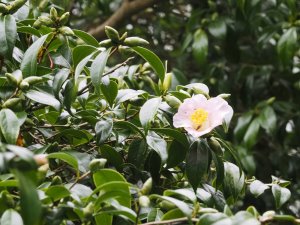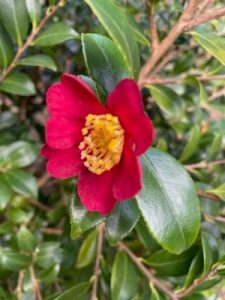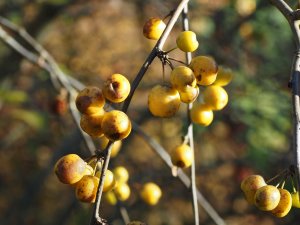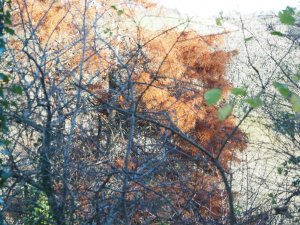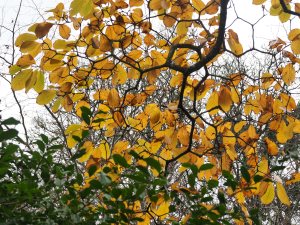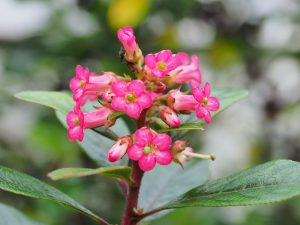2024 – CHW
Storm Bert brought down half of one of the original two Magnolia salicifolia which first flowered in 1928. The core of the trunk was completely rotten but roots had grown into the rotten areas from the surviving live bit of the trunk. An odd phenomenon which I have seen before in a partly rotten Magnolia x soulangeana ‘Brozzoni’.

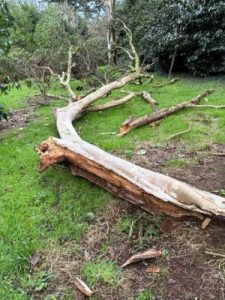


Jaimie’s early morning picture taken from the castle roof while clearing out the gutters.
Laurel cutting proceeds below Tin Garden.
Placing out the 18 cherry trees (two of each) in the newly fenced off strip below White Styles with Jaimie. We put in marker stakes in a staggered line at 7 meter spacings. A list of what is to be planted is attached below:
Prunus ‘Matsumae-Beni-Yutaka’
Prunus ‘Ukon’
Prunus ‘Shirotae’
Prunus ‘Tai-Haku’
Prunus ‘Horinji’
Prunus ‘Hokusai’
Prunus ‘Gyoiko’
Prunus ‘Ichiyo’ (‘Pink Champagne’)
Prunus ‘Matsumae Fuki’ (‘Chocolate Ice’)
Crataegus x lavalleei ‘Carrierei’
Acer x freemanii ‘Autumn Blaze’
Tilia cordata ‘Winter Orange’
So we come again to the three malus trees on Bond Street which are now fully ripe.1. Perhaps Malus ‘Golden Hornet’?
I will need to pay rather more attention to the flowers on these three early next summer.
Camellia maliflora on Bond Street. The older, larger plant is now dead. Sparse flowerer at the best of times and a collector’s item. This is not a species known in the wild in China but it came first to the UK as a form of sasanqua in 1818.
In tier 1:
• you must not socialise in groups larger than 6 people, indoors or outdoors, other than where a legal exemption applies. This is called the ‘rule of 6’
• businesses and venues can remain open, in a COVID secure manner, other than those which remain closed by law, such as nightclubs
• hospitality businesses selling food or drink for consumption on their premises are required to:
• provide table service only, for premises that serve alcohol
• close between 11pm and 5am (hospitality venues in airports, ports, on transport services and in motorway service areas are exempt)
• stop taking orders after 10pm
• hospitality businesses and venues selling food and drink for consumption off the premises can continue to do so after 10pm as long as this is through delivery service, click-and-collect or drive-through
• early closure (11pm) applies to casinos, cinemas, theatres, concert halls, museums, bowling alleys, amusement arcades, funfairs, theme parks, adventure parks and activities and bingo halls. Cinemas, theatres and concert halls can stay open beyond 11pm in order to conclude performances that start before 10pm
• public attendance at outdoor and indoor events (performances and shows) is permitted, limited to whichever is lower: 50% capacity, or either 4,000 people outdoors or 1,000 people indoors
• public attendance at spectator sport and business events can resume inside and outside, subject to social contact rules and limited to whichever is lower: 50% capacity, or either 4,000 people outdoors or 1,000 people indoors
• places of worship remain open, but you must not attend or socialise in groups of more than 6 people while there, unless a legal exemption applies
• weddings and funerals can go ahead with restrictions on numbers of attendees – 15 people can attend wedding ceremonies and receptions, 30 people can attend funeral ceremonies, and 15 people can attend linked commemorative events
• organised outdoor sport, physical activity and exercise classes can continue
• organised indoor sport, physical activity and exercise classes can continue to take place, if the rule of 6 is followed. There are exceptions for indoor disability sport, sport for educational purposes, and supervised sport and physical activity for under-18s, which can take place with larger groups mixing
• if you live in a tier 1 area and travel to an area in a higher tier you should follow the rules for that area while you are there. Avoid travel to or overnight stays in tier 3 areas other than where necessary, such as for work, education, youth services, to receive medical treatment, or because of caring responsibilities. You can travel through a tier 3 area as part of a longer journey
• for international travel see the Foreign, Commonwealth and Development Office travel advice for your destination and the travel corridors list
2019 – CHW
The lower leaves on the record sized Magnolia x veitchii are a delicate yellow as another rainstorm threatens. I have never taken this in properly before. Higher up they are definitely a darker yellow.
Adult foliage finally starting to appear on Xanthocyparis vietnamensis. A good three years since this was planted and, as I have said before, in a stupid place. It needs moving!
The Camellia sasanqua clump below the greenhouse still full out – just double pinks today; the whites are over.
A solitary flower left on the arum (Zantedeshia aethiopica) by the gents’ loos. Looking at the growth on the clump this may be the first of next year’s flowers rather than the last of this year’s. No frost at all yet anyway!
2015 – CHW
We do not think of wisteria as being good autumn colour but just look at this adorning the outside gents’ loo! The actinidia grows through it and is still green. This is Wisteria sinensis ‘Black Dragon’ but other older wisteria growing in ancient yew trees are just as colourful at present. Another nice surprise on a day threatening to wet the shooting party.


1979 – FJW
Philip brought in xmas cheer for the house.
1927 – JCW
The quarry cherry has a fair lot of flowers. The early Hamamellis mollis is open.
1927 – JCW
Much as in 1923.
1923 – JCW
We have had some frost as compared with 1922. Berberis polyantha is good now. Some Erica codonodes in flower. H mollis is moving but not showing colour. C sasanquas frosted. Erica darleyense not quite open.
1922 – JCW
Roses – lapagerias – hydrangeas – Erica darleyense are all fair. I saw the first bit of Hamamelis mollis, also the first few Camellia sasanqua. There is only one Maddeni hybrid open but it is very lovely.
1911 – JCW
Solanum not quite all out or C sasanqua, but we have had some frost. Roses hold on and the Erica codonodes are opening nicely. Clematis cirrhosa is good.
1909 – JCW
We have had two weeks of frost. Ice on the pond. A very rainless late summer and autumn. Very few daffs of any age moving. C sasanqua has been cut. Rho decorum is in flower now and has been all Oct and Nov. Lapagerias over.
1908 – JCW
The finest autumn anyone can remember. Daffs of most ages are showing. Roses the best I have known so late. Solanum good. Iris alata and stylosa open etc.
1902 – JCW
Camellia sasanqua by the stables very good. A few seedlings of all ages are up. A good lot of roses yet. Have renewed the lapageria border.
1898 – JCW
Many seedlings above ground, say a dozen. Some 3 yr olds about 10. A good few yearlings moving in particular the maximus x but no 2 yr olds.






